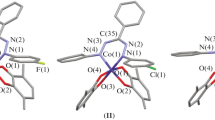Summary
Several cobalt(II) halide complexes derived from 1,8-bis(2-pyridyl)-3,6-dithiaoctane (bpdto) are described. Chemical analysis suggests their formulae to be: Co(bpdto)X2 (X=Cl−, Br−, or I−). Electrolytic conductivities in acetonitrile, magnetic moments at different temperatures, solid state i.r. and u.v.-visible spectra support a tetrahedral stereochemistry around the cobalt(II). The ligand is bidentate andN-bonded in all cases.
Similar content being viewed by others
References
H. A. Goodwin and F. Lions,J. Am. Chem. Soc., 82, 5013 (1960).
J. H. Worrell, J. J. Genova and T. D. DuBois,J. Inorg. Nucl. Chem., 40, 441 (1978).
G. R. Brubaker, J. N. Brown, M. K. Yoo, R. A. Kinsey, T. M. Kutchan and E. A. Mottel,Inorg. Chem., 18, 299 (1979).
W. J. Geray,Coord. Chem. Rev., 7, 81 (1971).
N. B. Colthup and L. H. Daly,Introduction to Infrared and Roman Spectroscopy, Academic Press, New York, 1964, p. 233.
D. K. Rastogi and K. C. Sharma,J. Inorg. Nucl. Chem., 36, 2219 (1974).
G. C. Kulassingam, W. R. McWhinnie and R. R. Thomas,Spectrochim. Acta, 22, 1365 (1966).
N. S. Gill, R. H. Nuttall, D. E. Scaife and D. W. A. Sharp,J. Inorg. Nucl. Chem., 18, 77 (1961).
M. Ohsaku,Bull. Chem. Soc. Jpn., 48, 707 (1975).
J. R. Ferraro,Low-Frequency Vibrations of Inorganic and Coordination Compounds, Plenum Press, New York, 1971, p. 205.
R. J. H. Clark and C. J. Williams,Inorg. Chem., 4, 350 (1965); D. H. Brown, K. P. Forrest, R. H. Nuttall and D. W. A. Sharp,J. Chem. Soc. A, 2148 (1968), N. S. Gill and H. J. Kingdon,Aust. J. Chem., 19, 2197 (1966).
D. M. Adams,Metal-Ligand and Related Vibrations, Edwards-Arnold, London, 1967.
F. E. Mabbs and M. J. Machin,Magnetism and Transition Metal Complexes, Chapman and Hall, London, 1973.
F. A. Cotton, D. M. L. Goodgame and M. Goodgame,J. Am. Chem. Soc., 83, 4690 (1961).
C. Simo and S. Holt,Inorg. Chem., 7, 2655 (1968).
E. König,Struct. Bonding (Berlin), 9, 175 (1971).
J. Owen,Proc. Roy. Soc. (London), A227, 183 (1955).
J. M. Land, J. A. Stubbs and J. T. Wrobleski,Inorg. Chem., 16, 1955 (1977).
Vogel's,Textbook of Quantitative Inorganic Analysis, 5th Ed., Longman, New York, 1978.
Author information
Authors and Affiliations
Additional information
This work was presented in the Fifth Annual Meeting of the Portuguese Chemical Society, Porto (Portugal), March 1982.
Rights and permissions
About this article
Cite this article
Castiñeiras, A., Molleda, C., Masaguer, J.R. et al. Complexes of 1,8-bis(2-pyridyl)-3,6-dithiaoctane with cobalt(II) halides. Transition Met Chem 8, 129–131 (1983). https://doi.org/10.1007/BF00956017
Received:
Issue Date:
DOI: https://doi.org/10.1007/BF00956017



